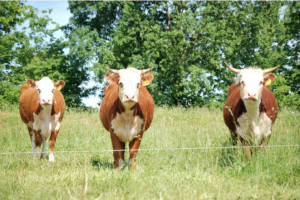Does power fence cost more to build than barbed wire?
No. Materials needed and labor required to build power fence are both significantly less than for barbed wire – up to $1,000 per mile less.
Isn't power fence intended to be a temporary fence?
High tensile power fence is every bit as permanent as barbed wire.
I'm building a permanent power fence with high tensile wire. Any suggestions?
Don't over-tension the wire. Using high-tensile wire allows for greater line post spacing than conventional wire; usually 50 feet as a minimum. Also, don't over-tighten the wires. Make sure it's a flexible system that allows for wildlife impacts, snow loading, etc. If you don't "over-engineer" the fence, you'll save a lot of money.
What should I keep in mind when using high-tensile wire for a permanent power fence?
The two most common errors we see are using too many line posts, and over tensioning the wire. Remember, this isn't barbed wire. Power fence is a mental barrier for your animals, not a physical one. When using high-tensile wire, it allows for greater line post spacing than conventional wire; usually 50 feet as a minimum. Also, don't over-tighten the wires. You want a flexible system that allows for wildlife impacts, snow loading, etc. Over-building a power fence makes it too rigid, and you lose this benefit. Plus, it costs you more for materials.
What is the best way to configure a permanent electric fence for cattle?
A one-wire cross will contain dairy or trained cattle. A five-wire boundary is necessary for stocker/yearlings or cow/calf operations. Use posts spaced 60-90 feet apart to support the wire.
Why is it best to run multiple hot wires instead of just one?
With more wire there is less resistance to current flow in the wires and less of the voltage is dropped in the line itself, which leaves more to shock the animal.
Is it OK to hook up a power fence energizer to barbed wire?
No. Animals can become entangled and trapped in the barbed wire, and while the shock emitted by our energizers is not sufficient to kill or seriously wound a farm animal, the stress of being trapped and repeatedly shocked can.
Is it OK to hook two energizers to the same line to increase power?
No. The components in our energizers are designed for specific voltage and current requirements. Hooking up two or more energizers to the same line will eventually destroy the energizers.
Which energizer should I use?
It depends on your situation. Gallagher makes many models with different capabilities. The questions to answer include:
-What animal are you controlling?
Domestic stock will take less power to control than fencing wildlife out of an area.
- How big an area do you need to fence?
Obviously, you will need a bigger energizer to carry adequate power on larger jobs. If there is a large vegetation challenge for the fence you will need more power. Plan now for any additions you may need down the road, too.
- What power source is available?
If you can, use a 110 or 220-volt plug-in energizer. If you can't, there is a wide range of battery and solar units available.
- Do you need a permanent or portable system?
If your needs dictate a portable system, one of our solar kits may fit well.
Why does the voltage increase as I move down the fenceline?
The voltage on your fence is greater closer to the end due to what is called the "bounce effect." This means that the pulse the energizer has sent down the fence reached the end and is returning back up the fence. It then meets the next pulse coming from the energizer creating a voltage spike or "bounce." This really means that your energizer joule rating is more than adequate for your fence load and has a surplus of energy, which is exactly what you want in your system.
Why do some small energizers show higher voltage readings directly out of the energizer than some larger ones?
Voltage merely represents a difference of potential between two electrical points and is only one aspect of overall power. The Joule rating is a true measure of an energizers stored energy or true power.
Electric Fencing
Are voltage regulators needed for solar energizers?
They are needed with solar panels 44 Watts or more. If a regulator is required, Gallagher pre-installs the unit prior to shipping any solar products.
What is a Joule?
A measurement of energy. A joule is a unit of work equal to product one watt for one second. It Is the measure of the pop, snap, shock, or kick or the pain/discomfort of the output pulse felt by the animal.
Will my animal get hurt when he hits the fence?
No the energizer puts out a pulse every second or less so there is time for the animal to get away from the fence.
What's the most common cause of power fence failures?
80% of all power fence problems can be traced to inadequate grounding. Your grounding system must be perfect for your fence to perform at its best. After all, it's half the system.
Why does my battery go dead after a week?
Improper grounding. Battery energizers will put energy into the negative side of the charger (green terminal) if not properly grounded, this also is connected to the negative battery post which then shocks the battery with positive electrons. Solution is to use the proper amount of galvanized grounds rods as recommended in the Power Fence Manual.
My animals don't respect power fences when the soil dries out. What can I do?
You have probably used an all-hot system (all fence wires are charged). Gallagher recommends all-hot systems only in areas with 35 inches or more of moisture per year. A hot/ground system might be a better choice. Make the top wire of your fence hot, then the next one down a ground wire, and so on. Tie the ground wires together with galvanized wire and clamps at the ends, then connect this to the ground rods, and the ground terminal of the energizer. This way, you carry the ground system out to the animal, and are not relying on dry soil to make the connection.
What does Gallagher recommend for grounding a permanent power fence system?
A minimum of three, six-foot long, galvanized steel ground rods, spaced at least 10 feet apart, and joined with one continuous galvanized wire clamped to the rods.
Can I use copper ground rods?
No. Copper ground rods are not recommended since copper will react with any galvanized steel through electrolysis, and corrode the connection. Gallagher uses only galvanized steel components to avoid this problem.
Why is it best to use galvanized grounding rods instead of just driving a large copper pole into the ground since copper is a good conductor?
Bare metals driven into the ground, regardless of their conductivity, are susceptible to oxidation and/or rust. Because power fence energizers emit only a brief, powerful jolt, it is very important that the conductivity of ground rods be maximized to insure that the animal receives a good shock.
How do I carry the hot and ground past all the gates in my fence?
The best way is to bury heavy-duty insulated cable in a trench about 10 inches deep. Make sure it's rated to 20,000 volts minimum or it may leak current with today's high-power energizers. Do not staple it to the post. Remember to carry the ground wire across the gateway also, using the same type of cable. It can be buried in the same trench as the hot cable.
Can I use bare wire to carry the ground under my gates?
No. Use heavy-duty insulated cable for the ground wire. Even good Class III galvanized wire will corrode rapidly when in contact with the soil. Corrosion leads to electricity resistance and soon there is no connection at all.
Will the electric netting work for free range poultry?
Yes, in most cases as long as the birds are clipped wing or are a non-flying species like Cornish. The netting will also act as a predator deterrent. It doesn’t take much of an energizer to contain a chicken, but a mid-range charger is needed if there is also a predator issue.


 Ron’s tried some other
Ron’s tried some other 













